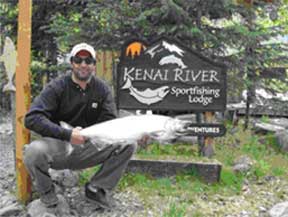Chugach National Forest
Encompassing 5.5 million acres, the Chugach National Forest in south central Alaska is the country’s northernmost temperate rainforest. This forest is home to large populations of moose, wolves, black and grizzly bears, sea otters, orcas, lynx and wolverines. The Chugach also contains some of the richest wild salmon streams in America, tidewater glaciers, towering mountain peaks, and nationally-renowned places such as the Kenai Peninsula, Copper River Delta, and Prince William Sound. These areas represent some of the most extraordinary fish and wildlife habitats remaining in North America and are premier destinations for avid hunters and anglers. Second in size only to the Tongass, 99% of the forest is classified as roadless and qualifies for Wilderness designation. However, there is not a single acre of these wilderness-quality lands currently protected as designated Wilderness.
The Chugach faces extensive pressures including wide-ranging helicopter skiing, snowmobiling, and all-terrain vehicle use. Overall, the Chugach has experienced alarming increases in recreational uses and the threats associated with industrial-scale tourism which are of great concern to local communities. Increasing levels of human use on these sensitive and extraordinary landscapes could adversely affect the health of wildlife populations in the long-term.
The Chugach National Forest, in its entirety, is an extraordinary roadless backcountry forest with world class fish, wildlife and wilderness values.
There are three special places in this forest that provide remarkable habitat for fish and wildlife but have yet to receive permanent protection.

Sportfishing guide Kyle Kolodziejski back from
another successful day on the Kenai River.
Chugach National Forest, Alaska.
© Kyle Kolodziejski
The Kenai Peninsula
On the Kenai Peninsula portion of the Chugach, the Russian River is a world famous sockeye salmon fishery. However, the pressure on this resource is increasing as the Kenai Peninsula is accessible by road from Anchorage and is a very popular recreation area in south central Alaska. Additionally, the Kenai Peninsula has experienced a significant increase in development activities on private lands, including subdivisions and large-scale logging. The habitat fragmentation, degradation, and loss associated with these activities pose a long-term threat to fish and wildlife populations. These activities have also impacted brown bear habitat and population numbers. Kenai Peninsula brown bears are considered an isolated and sensitive population, and are currently being managed to ensure their long-term viability. For the time being, The Chugach National Forest provides a significant reserve on the Kenai for brown bear habitat, but these areas are not permanently protected.
Prince William Sound
A decade and a half after the Exxon Valdez oil spill, when nearly 11 million gallons of oil spilled into Prince William Sound, the Sound is still recovering and requires additional protection. Prince William Sound is both productive and spectacularly beautiful, with mountains cloaked by forest surrounding fiords where glaciers reach down to the sea. Congress intended to protect this extraordinary country with the passage of the Alaska National Interest Lands Conservation Act (ANILCA) in 1980 which created close to a 2 million acre Wilderness Study Area (WSA) in western Prince William Sound,. However, despite Forest Service’s 2002 recommendations that 1.4 million acres of the WSA be designated as Wilderness, not a single acre has been officially protected.
Copper River Delta
The Copper River Delta lies just east of Prince William Sound, and at 700,000 acres this magnificent wetlands complex supports critical migratory waterfowl populations on the Pacific Coast. Hunters in the lower 48 annually pursue these waterfowl which summer in the delta. The delta sustains one of the most prized salmon runs in the world. Development proposals still threaten these public lands just as they did when President Theodore Roosevelt established the Chugach National Forest in 1907.






